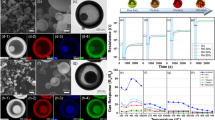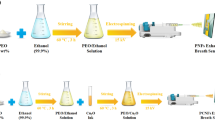Abstract
We propose a numerical investigation of a sensor for acetone monitoring in exhaled breath and exhaled breath condensate (EBC) using the surface plasmon resonance principle. For the theoretical analysis, we use the Kretschmann-Raether (K-R) setup and the Fresnel multilayer model. Four figures of merit, i.e., resonance angle (RA), minimum reflectance at resonance (MRR), full width at half maximum (FWHM), and sensitivity, are used for performance assessments. As the first step, we evaluate the performance of the sensor for various plasmonic metals and substrates. Results for emulations of exhaled breath indicated polycarbonate as the most suitable substrate for the scenario. For the exhaled breath condensate case, PMMA is deemed the optimal choice. Subsequently, we evaluate the effects of adding polyaniline (PANI), graphene, or chitosan as a chemisorption binding layer for the selective sensing of acetone. Our findings suggest that these materials are not able to improve SPR figures when using refractive indexes that emulate the exhaled breath scenario. For the exhaled breath condensate case, chitosan and graphene are able to improve the sensitivity of the sensor, achieving competitive values. Chitosan generates sensitivities of 246\(^{\circ }\)/RIU, 216\(^{\circ }\)/RIU, and 150\(^{\circ }\)/RIU in associations with gold, copper, and silver, respectively. Graphene stands as a second option by improving sensitivities of gold up to 210\(^{\circ }\)/RIU and silver up to 150\(^{\circ }\)/RIU.






Similar content being viewed by others
Availability of Data and Materials
No datasets were generated or analysed during the current study.
References
Pleil JD (2016) Breath biomarkers in toxicology. Arch Toxicol 90(11):2669–2682
Peralbo-Molina A, Calderon-Santiago M, Jurado-Gamez B, de Castro LMD, Priego-Capote F (2017) Exhaled breath condensate to discriminate individuals with different smoking habits by GC-TOF/MS. Sci Rep 7(1):1–13
Ratiu IA, Ligor T, Bocos-Bintintan V, Mayhew CA, Buszewski B (2020) Volatile organic compounds in exhaled breath as fingerprints of lung cancer, asthma and COPD. J Clin Med 10(1):32
Wang W, Zhou W, Wang S, Huang J, Le Y, Nie S, Wang W, Guo Q (2021) Accuracy of breath test for diabetes mellitus diagnosis: a systematic review and meta-analysis. BMJ Open Diabetes Res Care 9(1):e002174
Wallace MAG, Pleil JD (2018) Evolution of clinical and environmental health applications of exhaled breath research: review of methods and instrumentation for gas-phase, condensate, and aerosols. Anal Chim Acta 1024:18–38
Costa CP, Marques J, Silva D, Barbosa C, Oliveira AS, Santos M, Rocha SM (2021) Metabolomics profiling of human exhaled breath condensate by SPME/GC\(\times\) GC-ToFMS: exploratory study on the use of face masks at the level of lipid peroxidation volatile markers. Microchem J 171
Wishart DS, Guo AC, Oler E, Wang F, Anjum A, Peters H, Dizon R, Sayeeda Z, Tian S, Lee BL et al (2022) HMDB 5.0: the human metabolome database for 2022. Nucleic Acids Res 50(D1):D622–D631
Baharuddin AA, Ang BC, Haseeb ASMA, Wong YC, Wong YH (2019) Advances in chemiresistive sensors for acetone gas detection. Mater Sci Semiconduct Process 103:104616
El Kazzy M, Weerakkody JS, Hurot C, Mathey R, Buhot A, Scaramozzino N, Hou Y (2021) An overview of artificial olfaction systems with a focus on surface plasmon resonance for the analysis of volatile organic compounds. Biosensors 11(8):244
Masikini M, Chowdhury M, Nemraoui O (2020) Metal oxides: application in exhaled breath acetone chemiresistive sensors. J Electrochem Soc 167(3)
Rifat AA, Haider F, Ahmed R, Mahdiraji GA, Adikan FRM, Miroshnichenko AE (2018) Highly sensitive selectively coated photonic crystal fiber-based plasmonic sensor. Opt Lett 43(4):891–894
Takatori K, Okamoto T, Ishibashi K, Micheletto R (2017) Surface exciton polaritons supported by a J-aggregate-dye/air interface at room temperature. Opt Lett 42(19):3876–3879
Yesudasu V, Pradhan HS, Pandya RJ (2021) Recent progress in surface plasmon resonance based sensors: a comprehensive review. Elsevier 7
Song H, Wang Q, Zhao WM (2020) A novel SPR sensor sensitivity-enhancing method for immunoassay by inserting MoS2 nanosheets between metal film and fiber. Opt Lasers Eng 132
Wei W et al (2018) Graphene/au-enhanced plastic clad silica fiber optic surface plasmon resonance sensor. Plasmonics 13
Zhang Y et al (2019) Sensitivity-enhanced fiber plasmonic sensor utilizing molybdenum disulfide nanosheets. J Phys Chem C 123
Vahed H, Nadri C (2019) Sensitivity enhancement of SPR optical biosensor based on graphene-MoS2 structure with nanocomposite layer. J Phys Chem C 88
Wang Q, Jiang X, Niu LY, Fan XC (2020) Enhanced sensitivity of bimetallic optical fiber SPR sensor based on mos2 nanosheets. Opt Lasers Eng 128
Almawgani AHM, Daher MG, Taya SA, Olaimat MM, Alhawari ARH, Colak I (2022) Detection of blood plasma concentration theoretically using SPR-based biosensor employing black phosphor layers and different metals. Plasmonics 17(4):1751–1764
Yadav A, Kumar A, Sharan P (2022) Sensitivity enhancement of a plasmonic biosensor for urine glucose detection by employing black phosphorous. JOSA B 39(1):200–206
Yadav A, Kumar A, Sharan P, Mishra M (2023) Highly sensitive bimetallic-metal nitride SPR biosensor for urine glucose detection. IEEE Trans NanoBiosci
Yadav A, Mishra M, Tripathy SK, Kumar A, Singh OP, Sharan P (2023) Improved surface plasmon effect in Ag-based SPR biosensor with graphene and WS2: an approach towards low cost urine-glucose detection. Plasmonics pp 1–11
Rahman MS, Rikta KA, Bashar LB, Anower MS (2018) Numerical analysis of graphene coated surface plasmon resonance biosensors for biomedical applications. Optik 156:384–390
Karki B, Salah NH, Srivastava G, Muduli A, Yadav RB (2023) A simulation study for dengue virus detection using surface plasmon resonance sensor heterostructure of silver, barium titanate, and cerium oxide. Plasmonics 18(6):2031–2040
Sun P, Wang M, Liu L, Jiao L, Du W, Xia F, Liu M, Kong W, Dong L, Yun M (2019) Sensitivity enhancement of surface plasmon resonance biosensor based on graphene and barium titanate layers. Appl Surf Sci 475:342–347
Do J-S, Wang S-H (2013) On the sensitivity of conductimetric acetone gas sensor based on polypyrrole and polyaniline conducting polymers. Sens Actuators B Chem 185:39–46
Mohammad Yusof N, Ibrahim S, Rozali S (2022) Advances on graphene-based gas sensors for acetone detection based on its physical and chemical attributes. J Mater Res pp 1–19
Skryshevsky VA, Milovanov YS, Gavrilchenko IV, Tiagulskyi SI, Rusavsky AV, Lysenko VS, Nazarov AN (2015) Impedance spectroscopy of single graphene layer at gas adsorption. Phys Status Solidi (A) 212(9):1941–1945
Nasution TI, Nainggolan I, Hutagalung SD, Ahmad KR, Ahmad ZA (2013) The sensing mechanism and detection of low concentration acetone using chitosan-based sensors. Sens Actuators B Chem 177:522–528
Myers M, Cooper J, Pejcic B, Baker M, Raguse B, Wieczorek L (2011) Functionalized graphene as an aqueous phase chemiresistor sensing material. Sens Actuators B Chem 155(1):154–158
Li P, Zhang D, Zhang Y, Lu W, Wang W, Chen T (2018) Ultrafast and efficient detection of formaldehyde in aqueous solutions using chitosan-based fluorescent polymers. ACS Sens 3(11):2394–2401
Terán-Alcocer Á, Bravo-Plascencia F, Cevallos-Morillo C, Palma-Cando A (2021) Electrochemical sensors based on conducting polymers for the aqueous detection of biologically relevant molecules. Nanomaterials 11(1):252
Shrivastav AM, Mishra SK, Gupta BD (2015) Surface plasmon resonance-based fiber optic sensor for the detection of ascorbic acid utilizing molecularly imprinted polyaniline film. Plasmonics 10:1853–1861
Gupta BD, Shrivastav AM, Usha SP (2016) Surface plasmon resonance-based fiber optic sensors utilizing molecular imprinting. Sensors 16(9):1381
Oliveira LC, Marcus Nogueira Lima A, Thirstrup C, Neff HF (2019) Surface plasmon resonance sensors: a materials guide to design, characterization, optimization, and usage, vol. 70. Springer
Reather H (1988) Surface plasmons on smooth and rough surfaces and on gratings. Springer Tracts Mod Phys 111(71):345–398
Homola J (2006) Surface plasmon resonance sensors, vol. 4. Springer
Oliveira LC, Lima AMN, Thirstrup C, Neff H (2015) Surface plasmon resonance sensors - a materials guide to design and optimization, vol. 1. Springer
West PR, Ishii S, Naik GV, Emani NK, Shalaev VM, Boltasseva A (2010) Searching for better plasmonic materials. Laser Photonics Rev 4(6):795–808
Moreira CS, Lima AMN, Neff H, Thirstrup C (2008) Temperature-dependent sensitivity of surface plasmon resonance sensors at the gold-water interface. Sens Actuators B Chem 134(2):854–862
Polinie M et al (2008) Plasmons and the spectral function of graphene. Phys Rev B 77
Oliveira LC, da Silva Moreira C, Thirstrup C, Melcher EUK, Lima AMN, Neff H (2013) A surface plasmon resonance biochip that operates both in the angular and wavelength interrogation modes. IEEE TIM 62(5):1223–1232
Oliveira LC, Moreira CS, Neff H, Lima AMN (2016) Optical properties and instrumental performance of thin noble metal (Cu, Au, Ag) films near the surface plasmon resonance. Procedia Eng 168:833–837
Oiveira LC, Herbster A, Moreira CS, Neff H, Lima AMN (2017) Surface plasmon resonance sensing characteristics of thin aluminum films in aqueous solution. IEEE Sens J 17(19):6258–6267
Mikhail N (2023) Polyanskiy. Refractive index database. https://refractiveindex.info. (Accessed 8 Nov 2023)
Bouarissa A, Gueddim A, Bouarissa N, Djellali S (2018) Band structure and optical properties of polyaniline polymer material. Polym Bull 75:3023–3033
Azofeifa DE, Arguedas HJ, Vargas WE (2012) Optical properties of chitin and chitosan biopolymers with application to structural color analysis. Opt Mater 35(2):175–183
Bondue CJ, Liang Z, Koper MTM (2021) Dissociative adsorption of acetone on platinum single-crystal electrodes. J Phys Chem C 125(12):6643–6649
Dey B, Sherajul Islam Md, Park J (2021) Numerical design of high-performance WS2/metal/WS2/graphene heterostructure based surface plasmon resonance refractive index sensor. Results Phys 23:104021
Rahman MdM, Abdulrazak LF, Ahsan M, Based MdA, Rana MdM, Anower MdS, Rikta KA, Haider J, Gurusamy S (2021) 2d nanomaterial-based hybrid structured (au-wse 2-ptse 2-bp) surface plasmon resonance (spr) sensor with improved performance. IEEE Access 10:689–698
Hossain B, Paul A, Islam MdA, Rahman MdM, Sarkar AK, Abdulrazak LF (2022) A highly sensitive surface plasmon resonance biosensor using SnSe allotrope and heterostructure of BlueP/MoS2 for cancerous cell detection. Optik 252:168506
Uddin SMA, Chowdhury SS, Kabir E (2021) Numerical analysis of a highly sensitive surface plasmon resonance sensor for SARS-CoV-2 detection. Plasmonics 16(6):2025–2037
Castriota M, Politano GG, Vena C, De Santo MP, Desiderio G, Davoli M, Cazzanelli E, Versace C (2019) Variable angle spectroscopic ellipsometry investigation of CVD-grown monolayer graphene. Appl Surf Sci 467:213–220
Wyatt QK, Young MJ (2020) Pulsed electrodeposition of ultrathin polyaniline films and mechanistic understanding of their anion-mediated electrochemical behavior. J Electrochem Soc 167(11):110548
Pavinatto FJ, Caseli L, Oliveira Jr ON (2010) Chitosan in nanostructured thin films. Biomacromolecules 11(8):1897–1908
Funding
This work was carried out with the support of the Coordenação de Aperfeiççoamento de Pessoal de Nível Superior - Brazil (CAPES) - Financing Code 001. The authors also thank Instituto Federal da Paraíba and Universidade Federal de Santa Catarina for all support.
Author information
Authors and Affiliations
Contributions
G. Fernandes, J. Marques, and C. Moreira devised the project and the main conceptual ideas. G. Fernandes worked out almost all of the technical details, and performed the numerical calculations for the suggested experiment. C. Moreira, H. Nascimento, and R. Cruz worked out the bound for surface plasmon resonance, with help from G. Fernandes. C. Moreira verified the numerical results. G. Fernandes and C. Moreira wrote the manuscript. All authors reviewed the manuscript.
Corresponding author
Ethics declarations
Ethical Approval
Not applicable
Competing Interests
The authors declare no competing interests.
Additional information
Publisher's Note
Springer Nature remains neutral with regard to jurisdictional claims in published maps and institutional affiliations.
Rights and permissions
Springer Nature or its licensor (e.g. a society or other partner) holds exclusive rights to this article under a publishing agreement with the author(s) or other rightsholder(s); author self-archiving of the accepted manuscript version of this article is solely governed by the terms of such publishing agreement and applicable law.
About this article
Cite this article
Monteiro Fernandes, G.B., Nascimento, H., Santa Cruz, R.M. et al. Investigation of a Plasmonic Optical Sensor for Acetone Detection in Exhaled Breath and Exhaled Breath Condensate. Plasmonics (2024). https://doi.org/10.1007/s11468-023-02190-4
Received:
Accepted:
Published:
DOI: https://doi.org/10.1007/s11468-023-02190-4




